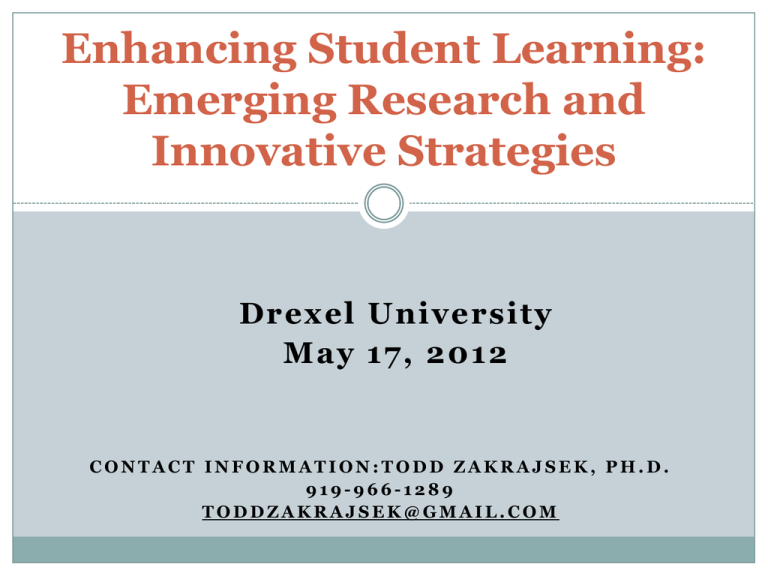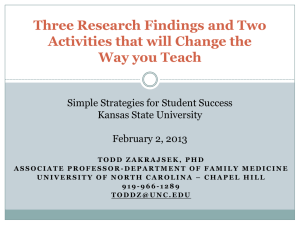Enhancing Student Learning: Emerging Research and Innovative Strategies Drexel University
advertisement

Enhancing Student Learning: Emerging Research and Innovative Strategies Drexel University May 17, 2012 CONTACT INFORMATION:TODD ZAKRAJSEK, PH.D. 919-966-1289 TODDZAKRAJSEK@GMAIL.COM Design for Learning What is your anticipated outcome? How will you accomplish that outcome? How will you know you were successful? Drexel Learning Goals Core Intellectual and Practical Skills Communication Creative and Critical Thinking Ethical Reasoning Information Literacy Self-Directed Learning Technology Use Drexel Learning Goals Experiential and Applied Learning Global Competence Leadership Professional Practice Research, Scholarship, and Creative Expression Responsible Citizenship Seven Principles for Good Practice in Undergraduate Education (Chickering & Gamson, 1996) Contact between student and faculty Develops reciprocity and cooperation among students Uses active learning techniques Prompt feedback Time on task (motivation to learn) Communicate high expectations Respects diverse talents and ways of knowing Long-Term Potentiation http://www.youtube.com/watch?v= DF04XPBj5uc Multitasking Automatic… Controlled… http://www.youtube.com/watch?v=vJG698U2Mvo Pashler, McDaniel, Rohrer, & Bjork, 2009 Learning Styles: Concepts and Evidence Learning Styles A Nasal Learner Struggles with an Odorless Textbook From the “Onion” Search Nasal Learners & Onion http://www.theonion.com/articles/parents-of-nasal-learners-demand-odorbasedcurricu,396/ Basketball…. Card passing What is one issue or concern you have with respect to your students and creating an effective learning environment? Body’s Reaction to Lecturing Bligh, 2000, What’s the Use of Lectures? 2000, p.51; Hartley & Davies, 1978, Programmed Learning and Educational Technology:15:207-224. Lecture Breaks Increase Students’ Attention Bligh, What’s the Use of Lectures? 2000, p.51. “Every beginning instructor discovers sooner or later that his first lectures were incomprehensible because he was talking to himself, so to say, mindful only of his point of view. He realizes only gradually and with difficulty that it is not easy to place one’s self in the shoes of students who do not yet know about the subject matter of the course.” Piaget (1962) Recht & Leslie (1988) Good Readers Items Correct Poor Readers 20 10 High Knowledge Low Knowledge Effort vs. Entity Mueller & Dweck, 1998 mug night vases vector http://www.manythings. org/anagrams/ gum thing saves covert marching nameless licensed teaching thickens charming salesman silenced cheating kitchens host inch fiber glare sisters shot chin brief large resists # Problems Solved Place “Smart” and “Effort” in Proper Place Standard Trial 1 Trial 3 # Problems Solved Effort Standard Smart Trial 1 Trial 3 Carol Dweck, 2006 Entity – fixed, less risk Incremental – growth, accepting challenge Karpicke & Roediger, 2007 SSSS SSST STTT Proportion of ideas recalled .80 .70 .60 .50 .40 5 Minutes 1 Week Retention Interval For Final Test The Effect of Overlearning on Long-Term Retention ROHRER, TAYLOR, PASHLER,WIXTED, & CEPEDA, 2005 Overlearners Control Proportion of items recalled .70 .50 .30 .10 1 Week 4 Weeks Retention Interval For Test 9 Weeks Learners must be taught to take a metacognitive approach. Bransford, et al., How People Learn, 1999 http://www.nap.edu/openbook.php?record_id=6160 Types of CATs Minute Paper (check understanding at end of class session) Muddiest Point (check understanding at end of class session) One-Sentence Summary (check understanding at end of class session) Directed Paraphrasing (check understanding of a concept) Lecture Checks (Mazur’s Technique) Card Passing (very good for sensitive topics) Kennesaw Teaching Journals http://www.kennesaw.edu/cetl/res ources/journals.html



